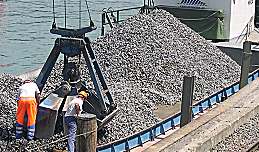Rock mechanics on:
[Wikipedia]
[Google]
[Amazon]
Rock mechanics is a theoretical and applied science of the mechanical behavior of rock and rock masses; compared to geology, it is that branch of Rock Mechanics and Rock Engineering




mechanics
Mechanics (from Ancient Greek: μηχανική, ''mēkhanikḗ'', "of machines") is the area of mathematics and physics concerned with the relationships between force, matter, and motion among physical objects. Forces applied to objec ...
concerned with the response of rock and rock masses to the force fields of their physical environment.


Background
Rock mechanics forms part of the much broader subject of geomechanics, which is concerned with the mechanical responses of all geological materials, including soils. Rock mechanics, as applied inengineering geology
Engineering geology is the application of geology to engineering study for the purpose of assuring that the geological factors regarding the location, design, construction, operation and maintenance of engineering works are recognized and acc ...
, mining
Mining is the extraction of valuable minerals or other geological materials from the Earth, usually from an ore body, lode, vein, seam, reef, or placer deposit. The exploitation of these deposits for raw material is based on the econom ...
, petroleum, and civil engineering
Civil engineering is a professional engineering discipline that deals with the design, construction, and maintenance of the physical and naturally built environment, including public works such as roads, bridges, canals, dams, airports, sewa ...
practice, is concerned with the application of the principles of engineering mechanics to the design of the rock structures generated by mining, drilling, reservoir production, or civil construction activity such as tunnels, mining shafts, underground excavations, open pit mines, oil and gas wells, geothermal energy
Geothermal energy is the thermal energy in the Earth's crust which originates from the formation of the planet and from radioactive decay of materials in currently uncertain but possibly roughly equal proportions. The high temperature and pr ...
systems, road cuts, waste repositories, and other structures built in or of rock. It also includes the design of reinforcement systems, such as rock bolt
A rock bolt is a long anchor bolt, for stabilizing rock excavations, which may be used in tunnels or rock cuts. It transfers load from the unstable exterior to the confined (and much stronger) interior of the rock mass.
Rock bolts were first use ...
ing patterns.
See also
*Engineering geology
Engineering geology is the application of geology to engineering study for the purpose of assuring that the geological factors regarding the location, design, construction, operation and maintenance of engineering works are recognized and acc ...
* Geotechnical engineering
Geotechnical engineering is the branch of civil engineering concerned with the engineering behavior of earth materials. It uses the principles of soil mechanics and rock mechanics for the solution of its respective engineering problems. It ...
* Rock mass classification Rock mass classification systems are used for various engineering design and stability analysis. These are based on empirical relations between rock mass parameters and engineering applications, such as tunnels, slopes, foundations, and excavatabili ...
* Slope stability analysis
* Rock mass plasticity
300px, Boudinaged quartz vein (with strain fringe) showing ''Fault (geology)">sinistral shear sense'', Starlight Pit, Fortnum Gold Mine, Western Australia
Plasticity theory for rocks is concerned with the response of rocks to loads beyond the e ...
* SMR classification
Rock mechanics is a theoretical and applied science of the mechanical behavior of rock and rock masses; it is that branch of mechanics concerned with the response of rock and rock masses to the force fields of their physical environment. Rock mechanics is concerned with the application of the principles of engineering mechanics to the design of structures built in or of rock. The structure could include-but not limited to- a drill hole, a mining shaft, a tunnel, a reservoir dam, a repository component, or a building. Rock mechanics is used in many engineering disciplines, but primarily used in Mining, Civil, Geotechnical, Transportation, and Petroleum Engineering.
References
* * Brady, B.H.G., Brown, E.T. (1999), ''Rock Mechanics For Underground Mining,'' Kluwer Academic Publishers. * Coates, D F. (1981) "Rock Mechanics Principles." Canada: Monograph 874. {{Authority control Petrology Soil mechanics Mining engineering